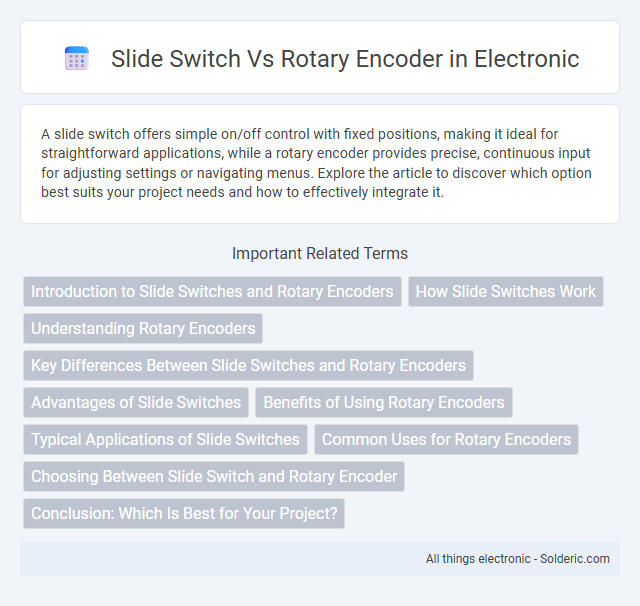A slide switch offers simple on/off control with fixed positions, making it ideal for straightforward applications, while a rotary encoder provides precise, continuous input for adjusting settings or navigating menus. Explore the article to discover which option best suits your project needs and how to effectively integrate it.
Comparison Table
| Feature | Slide Switch | Rotary Encoder |
|---|---|---|
| Function | On/Off or position selection | Rotational position input, detects direction and steps |
| Operation Type | Linear sliding | Rotational turning |
| Position Count | Limited discrete positions (usually 2-4) | Multiple continuous or incremental positions |
| Signal Output | Simple On/Off or positional contacts | Quadrature signals for direction and steps |
| Durability | Moderate mechanical wear | High durability with minimal wear |
| Typical Use Cases | Power toggling, mode selection | Volume control, menu navigation, rotary input |
| Complexity | Simple wiring and interface | Requires decoding circuits/software |
| Cost | Lower cost | Higher cost |
Introduction to Slide Switches and Rotary Encoders
Slide switches, known for their simple on/off functionality, are widely used in electronic devices to control power or signal flow with a straightforward sliding mechanism. Rotary encoders, on the other hand, provide precise rotational position feedback by converting angular movement into digital signals, making them essential for applications requiring accurate input control. Your choice between these components depends on whether you need basic switching or detailed position tracking in your project.
How Slide Switches Work
Slide switches operate by sliding an actuator back and forth to open or close electrical contacts, controlling the flow of current in a circuit. Their simple mechanical design allows for reliable on/off switching with tactile feedback, making them ideal for low-power applications. You can easily integrate slide switches for straightforward binary input without complex signal processing.
Understanding Rotary Encoders
Rotary encoders provide precise angular position feedback by converting rotational motion into electrical signals, offering advantages over slide switches that only provide simple on/off states. Your projects benefit from rotary encoders when you need incremental control, such as adjusting volume or navigating menus, due to their ability to detect direction and speed of rotation. Understanding the difference in functionality and applications helps in selecting the ideal component for accurate input response.
Key Differences Between Slide Switches and Rotary Encoders
Slide switches provide simple on/off functionality by sliding a lever between fixed positions, ideal for binary or limited-state inputs. Rotary encoders offer continuous rotational input, detecting angular position or movement direction, making them suitable for precise control tasks. You should choose slide switches for straightforward toggling and rotary encoders when variable input or incremental adjustments are required.
Advantages of Slide Switches
Slide switches offer straightforward operation with a simple sliding mechanism that ensures reliable on/off control, making them ideal for applications requiring minimal user effort and clear tactile feedback. They consume very low power and have a compact design, allowing for easy installation in space-constrained devices. Your projects benefit from their durability and long mechanical life, providing consistent performance in various environmental conditions.
Benefits of Using Rotary Encoders
Rotary encoders offer precise incremental position feedback, enabling accurate control in applications like volume knobs and industrial machinery. Their ability to provide infinite rotation without mechanical stops allows for seamless user interaction and extended durability compared to slide switches. High resolution and speed responsiveness make rotary encoders ideal for complex input tasks requiring fine adjustments and real-time data processing.
Typical Applications of Slide Switches
Slide switches are commonly used in small electronic devices such as remote controls, flashlights, and toys for simple on/off operations or mode selection due to their reliable, low-profile design. They are ideal for applications requiring straightforward manual control with tactile feedback, often seen in instrumentation panels and consumer electronics. Slide switches excel in scenarios demanding an easy-to-use, compact switching mechanism without the need for rotary functionality or incremental position sensing.
Common Uses for Rotary Encoders
Rotary encoders are commonly used in applications requiring precise control of position or speed, such as volume knobs on audio equipment, motor control systems, and industrial machinery interfaces. Unlike slide switches which provide simple on/off states, rotary encoders deliver continuous feedback for incremental adjustments and rotational input detection. Your design benefits from rotary encoders when accurate position sensing and user interaction with smooth variable control are essential.
Choosing Between Slide Switch and Rotary Encoder
Selecting between a slide switch and a rotary encoder depends on application requirements including space constraints, user interface complexity, and precision control needs. Slide switches offer simple on/off or binary position control, making them ideal for straightforward state selection with limited positional options. Rotary encoders provide continuous rotational input and fine granularity, enabling precise adjustments in devices such as volume controls, menu navigation, or incremental settings.
Conclusion: Which Is Best for Your Project?
A slide switch offers simple on/off control with straightforward installation and minimal power consumption, making it ideal for basic projects requiring reliable, tactile feedback. A rotary encoder provides precise, continuous input and greater customization options, perfect for applications needing variable control or multi-directional input. Your project's complexity and control needs determine whether the slide switch's simplicity or the rotary encoder's versatility is best suited.
slide switch vs rotary encoder Infographic

 solderic.com
solderic.com